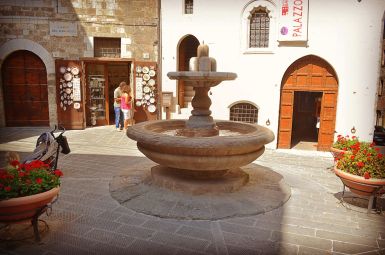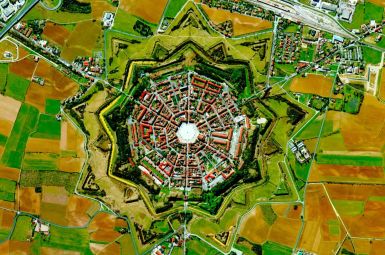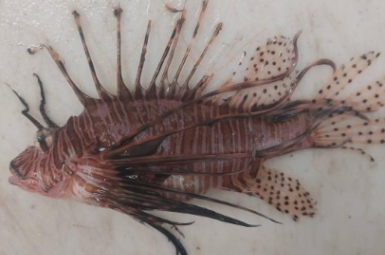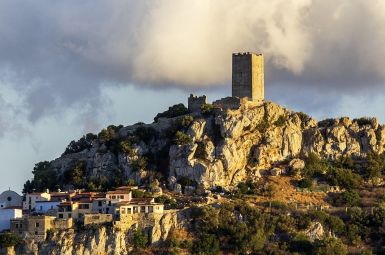
Pietrapertosa
Il Borgo di Pietrapertosa
Pietrapertosa: Dove il Borgo è Scultura, e l’Avventura Vola
Pietrapertosa (PZ) non è solo un borgo della Basilicata; è una sfida alla gravità, l’espressione più audace dell’architettura rupestre e il comune più alto della regione, incastonato a 1088 metri d’altitudine. Qui, tra le guglie imponenti delle Dolomiti Lucane, la roccia non è un ostacolo, ma la matrice stessa della vita. Appartenente al club dei “Borghi più belli d’Italia”, Pietrapertosa è la destinazione per chi cerca un viaggio che sia un’immersione nella storia geologica e un’esplorazione del proprio coraggio.Volo dell’Angelo: Sospesi tra Due Mondi
Il vero magnete che ha riscritto la storia turistica di Pietrapertosa è il Volo dell’Angelo.- L’Emozione Pura: Non è una semplice zip-line; è la possibilità di librarsi in volo a oltre 400 metri d’altezza e raggiungere velocità fino a 120 km/h, con il vento sul viso e il cuore in gola. Questo cavo d’acciaio connette Pietrapertosa al borgo gemello di Castelmezzano, offrendo una prospettiva aerea unica su un paesaggio che, di norma, è riservato solo alle creature alate. È l’atto di fede che lega la Lucania all’avventura moderna.
La “Pietra Forata”: Storia e Architettura Saracena
Il nome stesso del borgo racchiude il suo destino e la sua morfologia unica.- L’Origine del Nome: Pietrapertosa deriva dall’antico termine Petraperciata, ovvero “pietra forata”, in riferimento a una grande rupe con un foro passante visibile nella parte alta del paese.
- L’Arabata: Passeggiare per Pietrapertosa è camminare nella storia. Il quartiere più antico e suggestivo è l’Arabata, che deve il suo nome alla dominazione saracena (IX-X secolo). Le case sono qui scolpite nella roccia viva, incastrandosi perfettamente tra gli anfratti, con vicoli stretti e scalinate ripide che sono un monumento open air al genio umano.
- Il Castello Normanno-Svevo: A dominare il borgo si trova l’antico Castello, fortificato dai Saraceni e poi dai Normanni. Raggiungibile attraverso gradini scavati nella roccia, le sue rovine offrono un punto di osservazione impareggiabile e raccontano storie di assedi, cavalieri e leggende, come il “Trono della Regina” scavato nella pietra.
Il Parco e i Sentieri: Trekking e Spiritualità
Pietrapertosa è la porta d’accesso privilegiata al Parco Regionale di Gallipoli Cognato e Piccole Dolomiti Lucane.- Sentiero delle Sette Pietre: Un percorso di trekking letterario che collega Pietrapertosa a Castelmezzano (alternativo al Volo dell’Angelo), ispirato a leggende e storie popolari locali, offrendo un’esperienza lenta e contemplativa della natura.
- Via Ferrata e Trekking Urbano: Per i più sportivi, il territorio offre diverse Vie Ferrate per arrampicarsi in sicurezza sulle guglie rocciose. All’interno del borgo, l’esplorazione tra chiese storiche (come la Chiesa Madre di San Giacomo Maggiore) e palazzi gentilizi è essa stessa un trekking urbano in salita.
Pietrapertosa è una destinazione per chi non si accontenta di guardare, ma vuole vivere. Pronto a immergerti nella roccia viva e ad attraversare il cielo?
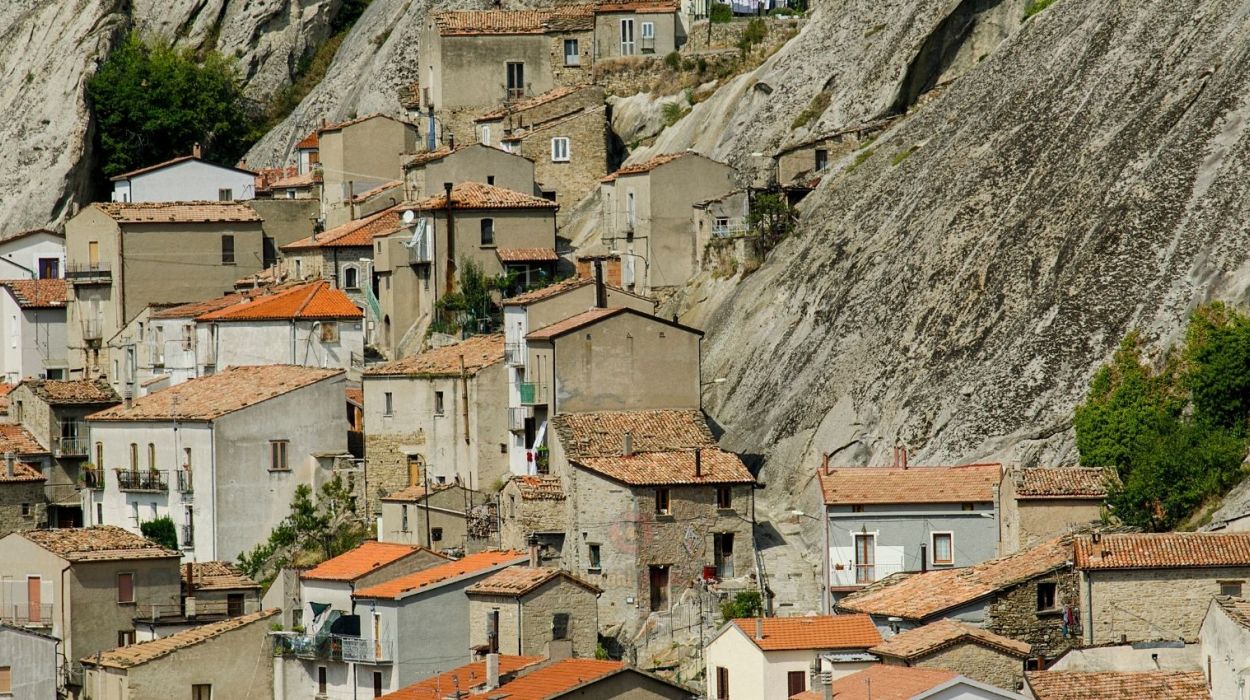
Il Borgo d’Italia
tutto da scoprire ed esplorare
Monumenti
Pietrapertosa: Monumenti Scolpiti nella Roccia e Sentinelle del Tempo
Pietrapertosa (PZ), il borgo più alto della Basilicata, non ha eretto monumenti nel senso tradizionale del termine: qui, sono le rocce stesse a essere monumentali, modellate dalla storia e dal genio umano. I suoi punti d’interesse sono fortezze naturali e quartieri interamente scavati, che offrono una prospettiva unica sull’architettura rupestre e sulla resilienza storica lucana.
Questi sono i monumenti che non solo si visitano, ma che si scalano, si attraversano e si sentono con il vento tra le guglie delle Dolomiti Lucane.
1. Il Castello Normanno-Svevo: Sentinella sulla Valle
La fortezza di Pietrapertosa è il monumento che ne domina lo skyline, un simbolo di difesa e potere perfettamente fuso con l’ambiente naturale.
- Fusione con la Roccia: Le sue vestigia non sono semplici mura, ma un complesso fortificato che si erge sulla sommità del monte, accessibile tramite scalinate e passaggi scavati direttamente nella roccia. Questa simbiosi tra architettura militare e geologia ne fa un esempio straordinario di ingegneria difensiva.
- Il Trono di Costanza: Tra le rovine, è ancora visibile il celebre “Trono della Regina”, un sedile naturale scavato nella pietra, che la leggenda vuole fosse il punto di osservazione privilegiato di Costanza d’Altavilla. Dalla cima, la vista spazia in modo ineguagliabile sull’intero paesaggio circostante.
2. L’Arabata: Il Monumento al Quartiere Saraceno
Il quartiere più antico di Pietrapertosa è esso stesso un monumento urbano, un tesoro di storia e architettura popolare.
- Architettura Rupestre: L’Arabata, il cui nome ricorda l’antica dominazione saracena (IX-X secolo), è un labirinto di vicoli stretti, case addossate e costruzioni che utilizzano la roccia viva come parete portante o fondazione. Percorrere l’Arabata è come camminare all’interno di una scultura geologica, dove ogni pietra racconta l’adattamento dell’uomo.
3. La Chiesa Madre di San Giacomo Maggiore
Nel cuore del borgo si trova il principale edificio di culto, custode di un patrimonio artistico sviluppato nei secoli.
- Stili e Tesori: La chiesa, dedicata a San Giacomo Maggiore, testimonia i rimaneggiamenti che si sono succeduti dal XIV secolo. Al suo interno, si possono ammirare tele, affreschi e il pregevole coro ligneo intagliato del XVI secolo, che conferiscono al luogo una dignità artistica sorprendente per un borgo così isolato.
4. Il Volo dell’Angelo: Il Monumento all’Avventura
Sebbene non sia una struttura in pietra, l’infrastruttura del Volo dell’Angelo è diventata il monumento moderno di Pietrapertosa alla sfida e al turismo.
- Opera di Connessione: È una linea di cavo d’acciaio che non solo offre un’emozione adrenalinica, ma unisce simbolicamente (e fisicamente) Pietrapertosa al borgo di Castelmezzano, trasformando lo spettacolare canyon delle Dolomiti Lucane in un palcoscenico per un’esperienza aerea indimenticabile.
A Pietrapertosa, ogni passo è un’esplorazione verticale. I suoi monumenti sono un’ode alla forza della natura e alla tenacia dell’uomo che l’ha saputa domare, o per meglio dire, abbracciare. Sei pronto a scoprirli tutti, dal basso fino al cielo?
Curiosità
Pietrapertosa: Curiosità e Segreti della “Pietra Forata” Lucana
**Pietrapertosa (PZ), il comune più alto della Basilicata, non è solo la base di lancio per il Volo dell’Angelo; è un labirinto di storia geologica e leggende popolari, dove l’uomo ha imparato a vivere in simbiosi con le imponenti Dolomiti Lucane. Il suo stesso nome è un indizio del carattere indomito di questo luogo.
Ecco le curiosità che fanno di Pietrapertosa un borgo unico, scolpito nella roccia e avvolto nel mito.
1. L’Origine del Nome: La Roccia Vivente
Il toponimo di Pietrapertosa è la prima, grande curiosità, un diretto riferimento alla morfologia del territorio.
- Petraperciata: Il nome deriva dal latino e dialettale Petraperciata, che significa letteralmente “pietra forata”. Questo si riferisce a una grande rupe forata in modo naturale che si trova nella parte alta del borgo, un fenomeno geologico così evidente da dare il nome all’intero insediamento.
2. Il Castello e il Trono Reale
Sulle cime rocciose che dominano il borgo si trovano i resti del Castello Normanno-Svevo, un luogo che nasconde una leggenda regale.
- Il Trono di Costanza: Tra le rovine della fortezza, i visitatori possono ammirare un sedile, o “trono”, scavato direttamente nella roccia. La leggenda narra che questo fosse il seggio prediletto da Costanza d’Altavilla, madre di Federico II di Svevia, che amava sedersi qui per ammirare il panorama e la sua terra.
3. Il Quartiere Arabata: Un’Eredità Lontana
Pietrapertosa vanta un rione che è l’evidenza fisica di una dominazione storica che ha lasciato un segno profondo nell’urbanistica.
- La Presenza Saracena: Il quartiere più antico e suggestivo, situato ai piedi del castello, si chiama “Arabata”. Il nome testimonia il periodo in cui i Saraceni dominarono quest’area (tra il IX e il X secolo). Le case di questa zona sono un capolavoro di architettura rupestre, costruite o, per meglio dire, incastonate e scolpite nella roccia, sfruttando ogni anfratto per la difesa e l’abitazione.
4. La Scena Cinematografica e Letteraria
La bellezza drammatica delle Dolomiti Lucane non è sfuggita all’occhio di registi e scrittori.
- Set Cinematografico: Pietrapertosa, insieme alla vicina Castelmezzano, è stata il set del fortunato film Un paese quasi perfetto (2016), che ha contribuito a far conoscere la magia di questi borghi al grande pubblico. Più recentemente, è apparsa anche in Moschettieri del re – La penultima missione (2018).
- Stephen King in Basilicata: Curiosamente, il borgo è citato nel romanzo L’istituto di Stephen King, dove viene indicata come sede italiana segreta di una misteriosa organizzazione governativa.
5. Il Maggio di Pietrapertosa: Il Matrimonio degli Alberi
Il paese mantiene vive antiche tradizioni legate al culto della natura e della fertilità.
- Rito Arboreo: Similmente ad altri borghi lucani, Pietrapertosa celebra il “Maggio”, un antico rito arboreo in onore di Sant’Antonio da Padova (e in passato, un culto pagano). L’evento culmina con l’innesto (il matrimonio) di due alberi – il tronco (u’ Maggio) e la cima (a’ Rocca) – che vengono scalati dai giovani del paese in un’emozionante prova di forza e coraggio.
Pietrapertosa è una destinazione per chi ama le storie che si possono toccare e le sfide che si possono superare. Sei pronto a esplorare i segreti della pietra e volare tra le sue guglie?
Personaggi
Pietrapertosa: Le Menti Nascoste tra le Dolomiti Lucane
Pietrapertosa (PZ), pur essendo un piccolo e remoto borgo incastonato nelle Dolomiti Lucane, non è rimasto estraneo alla storia e alla cultura. Le sue vette aguzze e la sua posizione isolata hanno forgiato spiriti acuti, dediti allo studio e all’erudizione, uomini che hanno portato la saggezza della Lucania sui palcoscenici nazionali e internazionali, in un’epoca in cui comunicare era già un’impresa.
Il borgo della “pietra forata” vanta figure di spicco che hanno lasciato un’impronta indelebile, dimostrando come il genio possa fiorire anche lontano dai grandi centri urbani.
Francesco Torraca: Il Dantista di Fama Mondiale
Il nome più celebre e autorevole legato a Pietrapertosa è quello di Francesco Torraca (1853 – 1938), il cui impatto sul mondo accademico va ben oltre i confini regionali.
- Critico e Filologo: Torraca è considerato uno dei massimi critici letterari e filologi italiani tra l’Ottocento e il Novecento. La sua specializzazione fu lo studio della letteratura italiana antica, in particolare di Dante Alighieri. Le sue interpretazioni e i suoi saggi sull’opera dantesca sono ancora oggi pietre miliari della critica.
- Professore Illustre: La sua carriera lo vide docente presso le più prestigiose università italiane, da Catania a Bologna, da Napoli a Roma, elevando il livello degli studi letterari in Italia. A Pietrapertosa, una statua lo ricorda come l’intellettuale che portò la sua terra nel mondo della cultura alta.
Le Figure Istituzionali: Impegno Civile e Politico
La storia del borgo ha visto anche figure che hanno dato un contributo significativo alla vita civile, spesso legando il loro operato alla storia del Regno di Napoli.
- Giambattista De Luca: Nel XVII secolo, fu un insigne giurista e cardinale, la cui influenza nel diritto e nella diplomazia ecclesiastica è nota. Sebbene non nativo di Pietrapertosa, la sua famiglia e il suo legame con il territorio lucano ne hanno consolidato la fama.
Eredi Moderni: La Forza dell’Arte e della Divulgazione
Oggi, l’eredità di Pietrapertosa rivive in una nuova generazione di artisti e intellettuali che continuano a promuovere la bellezza della Basilicata.
- La Nuova Cultura: Sebbene il borgo sia piccolo, continua ad attrarre e ispirare artisti e scrittori che scelgono le sue vette come rifugio creativo. Il Sentiero delle Sette Pietre, ad esempio, è un percorso di divulgazione che, attraverso installazioni artistiche e frammenti letterari, onora l’antica tradizione narrativa locale e il forte legame con il paesaggio.
Pietrapertosa è un borgo che, nonostante l’isolamento geografico, ha saputo generare menti capaci di decifrare i grandi testi della storia e di tessere nuove narrazioni. Sei curioso di scoprire quali segreti ispirarono il grande Torraca?
Ricette Tipiche
Pietrapertosa: I Sapori Robusti delle Dolomiti Lucane
Pietrapertosa (PZ), incastonata tra le guglie rocciose delle Dolomiti Lucane, offre una cucina che è l’essenza dell’entroterra lucano: sapori decisi, ingredienti semplici e un forte legame con la tradizione agropastorale. Qui, la tavola è un rifugio di autenticità, dove ogni ricetta è pensata per ristorare l’animo dopo una giornata tra i sentieri di montagna o, per i più audaci, dopo un volo tra i canyon.
Dalle ricette dei pastori a quelle delle feste, ecco i pilastri della gastronomia di questo borgo eccezionale.
1. I Primi: La Forza dei Legumi e della Pasta Povera
La base della dieta lucana è la semplicità, con un’enfasi su pasta fatta in casa e legumi coltivati nella valle.
Lagane e Ceci (o Fagioli): Il Piatto del Ristoro
Un classico intramontabile che simboleggia la cucina povera ma ricca di gusto della montagna.
- La Preparazione: Le lagane sono una pasta fresca, simile a larghe tagliatelle, preparata tradizionalmente solo con farina di grano duro e acqua. Vengono condite con un sugo denso e vellutato di ceci o fagioli (spesso tipologie locali come il fagiolo di Sarconi, I.G.P.). Il piatto viene arricchito da aglio, alloro, abbondante olio extra vergine d’oliva e immancabile peperoncino (diavulicchio), che accende il sapore robusto.
Rappasciona: La Minestra della Tradizione
na zuppa antica che unisce i tesori della terra.
- L’Unione Contadina: Questo piatto è una minestra che mescola vari legumi, come fagioli, lenticchie e ceci, spesso cotti insieme a cereali o verdure selvatiche. Rappresenta la celebrazione del raccolto e la ricchezza della biodiversità locale, un pasto completo e confortante, perfetto per le fresche serate in quota.
2. I Secondi: Carne, Montagna e Tradizione
Il territorio è ideale per l’allevamento, quindi le carni e i prodotti di norcineria occupano un posto d’onore.
Migliatello e Gnummareddi: L’Orgoglio del Pastore
Specialità che incarnano l’abilità e l’ingegno della tradizione pastorale.
- L’Essenza Lucana: Questi sono involtini di interiora di agnello o capretto (come fegato, polmone, e rognone), avvolti nella loro stessa retina o in foglie di verdure. Cotti alla brace o al forno, i migliatelli (più grandi) e gli gnummareddi (più piccoli) sono conditi con aromi selvatici come il prezzemolo e il peperoncino, offrendo un sapore intenso e caratteristico.
Cutturiddi (Agnello in Pignata): La Lentezza del Sapore
Un piatto che richiede pazienza e il calore del focolare.
- La Cottura Lenta: L’agnello (o il capretto) viene tagliato a pezzi e cotto a lungo in una pignata (pentola di terracotta) con patate, cipolle, pomodorini e spezie locali. La cottura lentissima e il recipiente in terracotta garantiscono una carne morbidissima e un sugo denso e aromatico.
3. Dolci e Prodotti Tipici
Il miele, le mandorle e i sapori semplici definiscono la pasticceria di Pietrapertosa.
Salsiccia Lucana (di Montagna)
Non una pietanza, ma un prodotto tipico fondamentale.
- Prodotto d’Eccellenza: La salsiccia di Pietrapertosa, prodotta con carni di suino e insaporita con finocchietto selvatico e peperoncino, è celebre per il suo sapore inconfondibile e la consistenza. Viene consumata fresca, stagionata o conservata sott’olio.
La cucina di Pietrapertosa è un viaggio sensoriale che ti connette direttamente con le sue rocce e i suoi boschi. Sei pronto a gustare la vera essenza della Lucania d’alta quota?
